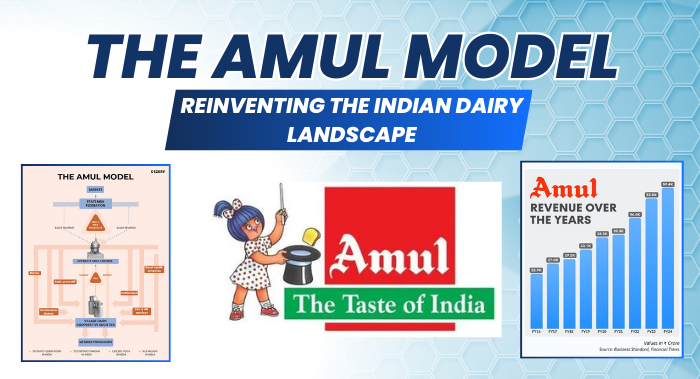- USA (TOLL FREE) -+ 1 (888) 445-5423, UK -+44-203-608-1089, IND -+919933983911
- info@iwebnext.com
×
The Can you imagine one day without consuming any Amul products? It is quite impossible for you, right? Amul has revolutionized itself and become a part of India’s daily life, producing dairy products like milk, butter, cheese, ice cream, etc. But did you know how a small cooperative evolved into a multi-billion-dollar brand?
Read this case study and discover the Amul success story . It is not just as a dairy company, but as a marketing phenomenon Amul has changed the face of the Indian dairy industry and consumer branding with its strong and unique marketing strategies.

Amul (Anand Milk Union Limited) was established in the year 1946 in Gujarat. At that time, local farmers were being exploited by middlemen who paid them very little for milk. For this, Dr. Verghese Kurien, often known as The Milkman of India, helped form a mutual system where the farmers possessed the brand.
That was named Amul, which stands for Anand Milk Union Limited. Over the years, the Amul success story has converted into a national phenomenon, because of its quality products due to Amul’s smart marketing, and strong connection with Indian households. This evolution has become one of the most engaging narratives in the Indian dairy industry.
The business model of Amul is built on a five-tier cooperative system. This makes the brand "for the people, by the people." The supply chain is managed in this order:
Each sector works together as a chain and distributes the profit amount among the 4 sectors orderly. This builds trust and loyalty as well as guarantees the quality of the product in the Amul success story .
Knowing its target audience is crucial for the success of any brand. With the diverse range of dairy products, the Amul brand case study shows how it connected with people across different lifestyles, business sectors, and age groups.
Its wide range of dairy products is designed for two key types of customers:
Business to Consumers (B2C) – B2C consists of various dairy products such as milk, butter, ice cream, cheese, chocolates, and flavored drinks. Amul has targeted customers for all age groups:
Business to Business (B2B) – Hotels, bakeries, street vendors, and restaurants buy bulk dairy products like paneer, butter, ghee, and milk regularly. This is a crucial part of the Indian dairy industry.
The Amul marketing strategy is often cited in marketing circles and business schools across the world. Let us explore the unique marketing strategies of Amul and know why Amul is called one of the most iconic in India.
The hand-drawn Amul Girl became a cultural icon in 1967. Dressed in her signature dress, the girl appears in a moment, marketing witty advertisements related to current events. Whether it is politics, sports, or films, the action of the Amul Girl changes according to advertisement events and reflects public sentiment with humour and intelligence. This marketing strategy, known as moment marketing, keeps Amul in the spotlight—always relevant, always loved.
Unlike other FMCG (fast-moving consumer goods) that launch new products, Amul does everything under its powerful brand, like butter, chocolates, ice cream, and pizzas. This decreases the cost of advertising, builds trust, and makes every product launch smoother.
Amul provides top-quality products at reasonable prices. This approach of value-for-money assists in reaching urban as well as rural customers. Amul does not spend too much on celebrity endorsements—it focuses consistently on the quality of products and memorable marketing.
The taglines of Amul are simple and relatable:
These taglines do not just advertise—they shape identity and loyalty. They are pillars of the Amul marketing strategy.
Amul did not stop at traditional media. Over the years, the brand has revolutionized smartly into the digital world.
Amul has started digital marketing across platforms like Twitter, Instagram, YouTube, and Facebook. It is a legendary moment in marketing with timely social media posts that go viral.
The website of Amul attracts millions of visitors every month through organic search. This success comes from strong Search Engine Optimization (SEO). The high domain authority of the website helps in ranking quickly for new pages.
Amul launched #SimpleHomemadeRecipes during COVID-19, encouraging people to cook at home using Amul products. More than 3,000 videos were uploaded from across India sharing unique recipes. This campaign shows both the Amul marketing strategy and the digital evolution of the Indian dairy industry.
The brand has launched several creative campaigns that connect with people across all generations. Explore some of its impactful and memorable campaigns, as highlighted in this Amul brand case study:
To honour the founder’s legacy, a massive bike rally from Jammu to Gujarat took place, which was not just symbolic but also connected with farmers on the ground and received extensive media coverage.
A digital content campaign promoted Amul products and used useful content so that consumers were attracted more to the campaign.
This nostalgic campaign replicated Amul as an iconic advertisement during COVID-19. Amul proved itself that great ads never die. This campaign demonstrates how Amul blends nostalgia with innovation in this Amul brand case study.
The Amul success story is more than just a story of dairy production, rather, it is a story of unity, innovation, and empowerment. Amul represents the perfect blend of quality, consistency, and creativity.
Amul’s unique model puts farmers in the leading position, guaranteeing rural development and fair income. Meanwhile, the marketing of Amul continues to evolve, moving from hand-painted billboards to viral digital campaigns.
Whether it is through its sparkling Amul Girl, strong digital strategies, or nostalgic taglines this Amul brand case study replicates that amazing marketing does not need expensive budgets—just valuable and strong ideas.